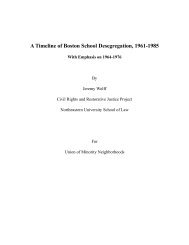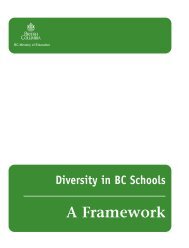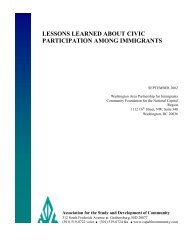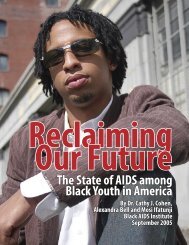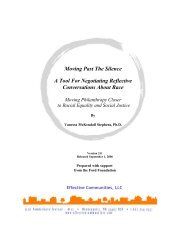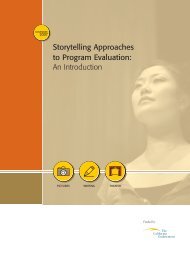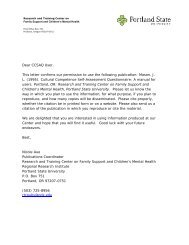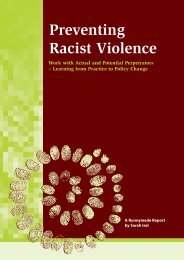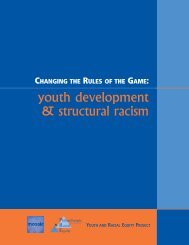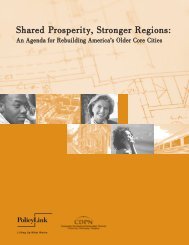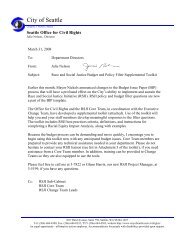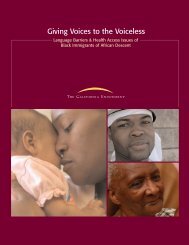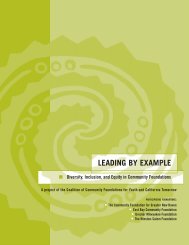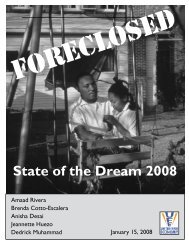Greyfield. An obsolete or ab<strong>and</strong>oned retail orcommercial site, usually a shopp<strong>in</strong>g mall.Hope VI. Also known as the Urban RevitalizationDemonstration, a grant program created <strong>in</strong> 1992 byCongress <strong>and</strong> the Department <strong>of</strong> Hous<strong>in</strong>g <strong>and</strong>Urban Development (HUD) to revitalize the nation’smost severely distressed public hous<strong>in</strong>g. Provides aflexible source <strong>of</strong> support (either revitalization grantsor demolition grants) for <strong>in</strong>vestment <strong>in</strong> publichous<strong>in</strong>g developments <strong>and</strong> their residents.Inclusionary zon<strong>in</strong>g. A l<strong>and</strong> use concept <strong>in</strong> whichlocal ord<strong>in</strong>ances require builders to <strong>in</strong>clude a certa<strong>in</strong>amount <strong>of</strong> hous<strong>in</strong>g for low- <strong>and</strong> moderate-<strong>in</strong>comehouseholds. In contrast, exclusionary zon<strong>in</strong>g is atechnique that effectively drives up the cost <strong>of</strong>hous<strong>in</strong>g, exclud<strong>in</strong>g lower-<strong>in</strong>come households fromthe community.Indicators. A series <strong>of</strong> measured communityattributes—such as school dropout rates, air quality,acres <strong>of</strong> urbanized l<strong>and</strong>, <strong>and</strong> health <strong>in</strong>surancecoverage—that are used to identify <strong>and</strong> monitorprogress on various aspects <strong>of</strong> the health <strong>of</strong> acommunity.Individual Development Account (IDA). A tooldesigned to enable low-<strong>in</strong>come <strong>and</strong> low-wealthAmerican families to save, build assets, <strong>and</strong> enter thef<strong>in</strong>ancial ma<strong>in</strong>stream. IDAs encourage sav<strong>in</strong>gs effortsamong the poor by <strong>of</strong>fer<strong>in</strong>g them 1:1, 2:1, or moregenerous matches for their own deposits. Thesematched sav<strong>in</strong>gs accounts are similar to 401(k) plans<strong>and</strong> other matched sav<strong>in</strong>gs accounts but can serve abroad range <strong>of</strong> purposes. IDA programs areimplemented by community-based organizations <strong>in</strong>partnership with a f<strong>in</strong>ancial <strong>in</strong>stitution that holds thedeposits <strong>and</strong> funded by public <strong>and</strong> private sources.Infill. The use <strong>of</strong> vacant l<strong>and</strong> <strong>and</strong> property with<strong>in</strong> abuilt-up area for new construction or redevelopment.Inner-r<strong>in</strong>g suburb. Those communities <strong>in</strong> betweenthe <strong>in</strong>ner city <strong>and</strong> outer-r<strong>in</strong>g suburbs. An emerg<strong>in</strong>gliterature def<strong>in</strong>es <strong>in</strong>ner-r<strong>in</strong>g suburbs <strong>in</strong> terms <strong>of</strong> theirspecific time <strong>of</strong> development, such as post WorldWar II communities constructed between 1945 <strong>and</strong>1965 <strong>and</strong> middle-aged neighborhoods that werebuilt from 1945 to 1970. Key to these def<strong>in</strong>itions isthe idea <strong>of</strong> <strong>in</strong>ner-r<strong>in</strong>g suburbs as post-WWIIdevelopedareas where the automobile was theprimary means <strong>of</strong> transportation.Livability. Quality <strong>of</strong> an area as perceived byresidents, employers, <strong>and</strong> visitors, <strong>in</strong>clud<strong>in</strong>g safety<strong>and</strong> health, environmental conditions, quality <strong>of</strong>social <strong>in</strong>teractions, opportunities for recreation <strong>and</strong>enterta<strong>in</strong>ment, aesthetics, <strong>and</strong> existence <strong>of</strong> cultural<strong>and</strong> environmental resources.Location efficient mortgage (LEM). A mortgagethat helps people become homeowners <strong>in</strong> locationefficient communities (convenient neighborhoods <strong>in</strong>which residents can walk from their homes to stores,schools, recreation, <strong>and</strong> public transportation).Because people who live <strong>in</strong> location efficientcommunities have less need to drive, which allowsthem to save money <strong>and</strong> improve the environmentfor everyone, LEMs comb<strong>in</strong>e a low down payment,competitive <strong>in</strong>terest rates, <strong>and</strong> flexible criteria forf<strong>in</strong>ancial qualification.Metropolitan equity. Similar to regional equity,metropolitan equity uses a greater than local lens forguid<strong>in</strong>g strategy <strong>and</strong> policy.Median <strong>in</strong>come. Median <strong>in</strong>come divides the <strong>in</strong>comedistribution <strong>in</strong>to two equal groups, one hav<strong>in</strong>g<strong>in</strong>comes above the median <strong>and</strong> the other hav<strong>in</strong>g<strong>in</strong>comes below the median.Mixed-use. Multiple l<strong>and</strong> uses, such as residential,retail, <strong>and</strong> <strong>of</strong>fice, comb<strong>in</strong>ed <strong>in</strong> a structure, on a s<strong>in</strong>gleparcel <strong>of</strong> l<strong>and</strong>, or built adjacent to one another onmultiple parcels.New Urbanism. International movement to restoreexist<strong>in</strong>g urban centers <strong>and</strong> towns, reconfiguresprawl<strong>in</strong>g suburbs <strong>in</strong>to communities <strong>of</strong> realneighborhoods <strong>and</strong> diverse districts, conserve naturalenvironments, preserve historic structures, <strong>and</strong> createcompact new towns <strong>and</strong> villages.Open space. Undeveloped l<strong>and</strong> or l<strong>and</strong> that is usedfor recreation, <strong>in</strong>clud<strong>in</strong>g farml<strong>and</strong> <strong>and</strong> naturalhabitats (e.g., forests, fields, wetl<strong>and</strong>s).Receivership. A form <strong>of</strong> bankruptcy <strong>in</strong> which acompany can avoid liquidation by reorganiz<strong>in</strong>g withthe help <strong>of</strong> a court-appo<strong>in</strong>ted trustee. In a localgovernment context, a form <strong>of</strong> bankruptcy where thestate assumes responsibility for a city’s f<strong>in</strong>ancialmanagement.Redl<strong>in</strong><strong>in</strong>g. The illegal practice <strong>of</strong> a lend<strong>in</strong>g<strong>in</strong>stitution deny<strong>in</strong>g loans or restrict<strong>in</strong>g their numberfor certa<strong>in</strong> areas <strong>of</strong> a community.123 Funders’ Network for Smart Growth <strong>and</strong> Livable Communities
<strong>Regional</strong> <strong>and</strong> neighborhood equity. A learn<strong>in</strong>g<strong>and</strong> action framework designed to: reduce social<strong>and</strong> economic disparities among <strong>in</strong>dividuals, socialgroups, neighborhoods, <strong>and</strong> local jurisdictionswith<strong>in</strong> a metropolitan area; connect neighborhoodsto regional <strong>and</strong> state public policy decisionmak<strong>in</strong>g;<strong>and</strong> harness private markets opportunities forcommunity benefits.Remediation. In environmental protection work, theact or process <strong>of</strong> correct<strong>in</strong>g a fault or deficiency.Retail leakage. The amount <strong>of</strong> money residents <strong>and</strong>workers spend outside a neighborhood because <strong>of</strong> alack <strong>of</strong> stores <strong>in</strong>side it.Section 8. A federal rent subsidy program thatprovides monthly assistance to low-<strong>in</strong>come<strong>in</strong>dividuals resid<strong>in</strong>g <strong>in</strong> privately owned units. Rentsmust be with<strong>in</strong> Department <strong>of</strong> Hous<strong>in</strong>g <strong>and</strong> UrbanDevelopment (HUD) limits <strong>and</strong> the units must meetHUD Hous<strong>in</strong>g Quality St<strong>and</strong>ards. Section 8 can beused <strong>in</strong> cooperatives to help lower-<strong>in</strong>comehouseholds pay their monthly carry<strong>in</strong>g charges.Smart growth. A series <strong>of</strong> policies <strong>and</strong> practices toensure that decisions about growth result <strong>in</strong> wellplanneddevelopment that protects open space <strong>and</strong>farml<strong>and</strong>, revitalizes communities, keeps hous<strong>in</strong>gaffordable, <strong>and</strong> provides transportation choices.Sprawl. The unplanned spread <strong>of</strong> urb<strong>and</strong>evelopment <strong>in</strong>to areas beyond the edges <strong>of</strong> a city.Sprawl def<strong>in</strong>es patterns <strong>of</strong> urban growth that <strong>in</strong>cludelarge acreage <strong>of</strong> low-density residential development,rigid separation between residential <strong>and</strong> commercialuses, development <strong>in</strong> rural areas away from urbancenters, strip commercial development alonghighways, <strong>and</strong> m<strong>in</strong>imal support for non-motorizedor alternative transportation.Susta<strong>in</strong>able development. Development with thegoal <strong>of</strong> preserv<strong>in</strong>g environmental quality, naturalresources, <strong>and</strong> livability for present <strong>and</strong> futuregenerations. Susta<strong>in</strong>able <strong>in</strong>itiatives work to ensureefficient use <strong>of</strong> resources.Transit-Oriented Development (TOD). Refers toresidential <strong>and</strong> commercial areas designed tomaximize access by transit <strong>and</strong> non-motorizedtransportation <strong>and</strong> with other features to encouragetransit ridership. A TOD neighborhood has a centerwith a rail or bus station, surrounded by relativelyhigh-density development, with progressively lowerdensitydevelopment spread<strong>in</strong>g outwards.Uniform Relocation Act. The Uniform RelocationAssistance <strong>and</strong> Real Property Acquisition Policies Act<strong>of</strong> 1970 (Uniform Act) provides importantprotections <strong>and</strong> assistance for people affected by theacquisition, rehabilitation, or demolition <strong>of</strong> realproperty for federal or federally-funded projects. Thislaw was enacted by Congress to ensure that peoplewhose real property is acquired, or who move as adirect result <strong>of</strong> projects receiv<strong>in</strong>g federal funds, aretreated fairly <strong>and</strong> equitably <strong>and</strong> receive assistance <strong>in</strong>mov<strong>in</strong>g from the property they occupy.Urban village. A place where people live, work,<strong>and</strong> play <strong>in</strong> harmony with each other <strong>and</strong> theenvironment. Often a neighborhood with<strong>in</strong> alarger city.Value latch<strong>in</strong>g. The concept <strong>of</strong> value latch<strong>in</strong>g is thatas downtown values rise—both rents <strong>and</strong> salesprices—a system <strong>of</strong> dedicated cash flow sources foraffordable hous<strong>in</strong>g <strong>and</strong> affordable commercial rentscould be negotiated. This process wouldsystematically latch onto ris<strong>in</strong>g property values <strong>and</strong>rents <strong>in</strong> order to provide a permanent source <strong>of</strong>fund<strong>in</strong>g for affordable hous<strong>in</strong>g/commercial rents.Weak market cities. A term characteriz<strong>in</strong>g urbancenters that saw decl<strong>in</strong>es <strong>in</strong> home values from 1990 to2000 <strong>and</strong> are considered places where tax bases <strong>and</strong>public services have eroded. There are more than 100“weak market cities” nationally, <strong>in</strong>clud<strong>in</strong>g 55 percent<strong>of</strong> those with populations <strong>of</strong> 100,000 or more.Part V: Glossary <strong>of</strong> Terms124
- Page 1 and 2:
Stories of Philanthropic Leadership
- Page 3 and 4:
Signs of Promise:Stories of Philant
- Page 5 and 6:
Funders’ Network for Smart Growth
- Page 7 and 8:
(II. B.)(II. C.)Turning Neighborhoo
- Page 9 and 10:
PART I:IntroductionThe Purpose of t
- Page 11 and 12:
social justice issues as they relat
- Page 13 and 14:
PART II:Perspectives on Advancing R
- Page 15 and 16:
peer work, we can reestablish a sig
- Page 17 and 18:
Annie E. Casey FoundationBaltimore,
- Page 19 and 20:
neighborhoods into healthy ones—g
- Page 21 and 22:
Charles and Helen Schwab Foundation
- Page 23 and 24:
Section 1:Promoting Equitable Publi
- Page 25 and 26:
I. A. BUILDING POWER AND GIVINGVOIC
- Page 27 and 28:
policy advocates. In 2002, Milwauke
- Page 29 and 30:
in Los Angeles, Ford’s Anthony no
- Page 31 and 32:
I. B. PROMOTING COALITIONSTO ADVANC
- Page 33 and 34:
Yet the interpersonal dynamics of c
- Page 35 and 36:
guidelines. “Many of the member o
- Page 37 and 38:
Funder InterestThe EPA supported th
- Page 39 and 40:
I. D. DEMONSTRATING THESTRUGGLE FOR
- Page 41 and 42:
Richmond, Calif.The second regional
- Page 43 and 44:
through policy reform at the local
- Page 45 and 46:
I. E. BUILDING COALITIONTHROUGH KNO
- Page 47 and 48:
organizing project, the Connecticut
- Page 49 and 50:
and businesses are quantified in a
- Page 51 and 52:
I. G. REVITALIZING WHILEASSURING DI
- Page 53 and 54:
In the late 1990s, the city of Albu
- Page 55 and 56:
I. H. A TRAVEZ DE LA FRONTERA:LAND
- Page 57 and 58:
The International Community Foundat
- Page 59 and 60:
I. I. MOBILIZING ACTION FORREGIONAL
- Page 61 and 62:
To meet all of these objectives, th
- Page 63 and 64:
efforts. And with each public plann
- Page 65 and 66:
pattern of disproportionate transpo
- Page 67 and 68:
Clinica de la Raza identify this cr
- Page 69 and 70:
Contact PeopleCarl AnthonyActing Di
- Page 71 and 72:
Section 2:Making All Neighborhoods
- Page 73 and 74:
II. A. REACHING BEYONDHOUSING TO IM
- Page 75 and 76:
A local resident receives the keys
- Page 77 and 78:
East Baltimore community and the Jo
- Page 79 and 80: example, adjacent to the EBDI area,
- Page 81 and 82: II. C. YIELDING REGIONALBENEFITS TH
- Page 83 and 84: is using transit-oriented developme
- Page 85 and 86: financing and innovative, forward-t
- Page 87 and 88: The Row House Community Development
- Page 89 and 90: II. E. COUNTERING THE PERFECTSTORM:
- Page 91 and 92: funded community programs, includin
- Page 93 and 94: housing developments and commercial
- Page 95 and 96: owned enterprises, totaling $8.5 mi
- Page 97 and 98: LOAN GUARANTEESSection 3:Connecting
- Page 99 and 100: III. A. MAKING HOUSING ANOPPORTUNIT
- Page 101 and 102: A new report from the National Hous
- Page 103 and 104: The Straphangers Campaign was found
- Page 105 and 106: Funder InterestThe Straphangers Cam
- Page 107 and 108: or increase poverty. Whether direct
- Page 109 and 110: The Regional Plan Association then
- Page 111 and 112: multi-stakeholder effort composed o
- Page 113 and 114: director with LISC. No one set of s
- Page 115 and 116: 12 western Louisville neighborhoods
- Page 117 and 118: III. E. UNITING THREE STATESFOR ONE
- Page 119 and 120: increased their personal wealth by
- Page 121 and 122: summary evaluation of MSDI found th
- Page 123 and 124: method alone was strong enough to m
- Page 125 and 126: consistent body of work. The Counci
- Page 127 and 128: 3) Issues Need to be ConnectedThe f
- Page 129: PART V:Glossary of TermsThe terms d
- Page 133 and 134: Tijuana River Reserve, California:h
- Page 135 and 136: Sargent Shriver National Center on
- Page 137: 1500 San Remo Avenue • Suite 249



